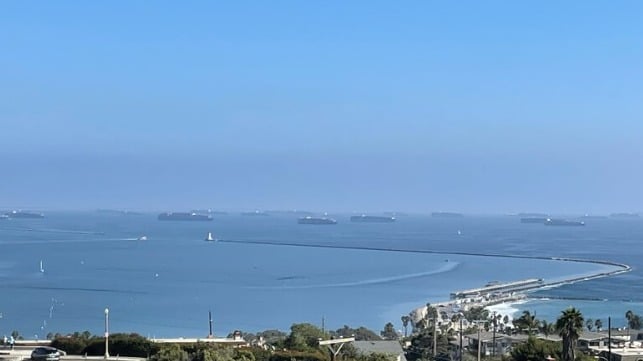New Process Managing Containerships to Reduce Ships at Anchor in SoCal

To better manage the flow of containerships into the San Pedro Bay ports while addressing concerns over safety and the environment, a working group from the maritime industry has formulated a new process for vessels heading to the ports of Los Angeles and Long Beach. The new process is designed to dramatically reduce the number of backlogged ships at anchor off the coast.
The system, which becomes effective on November 16, calls for each vessel to be assigned a place in the arrival queue based on their departure time from their last port of call. Developed by the Pacific Maritime Association, Pacific Merchant Shipping Association, and Marine Exchange of Southern California, as well as individuals from member companies, the new procedures will allow vessels to slow their speed and spread out, reducing vessels at anchor before the onset of winter weather, in addition to reducing emissions near the coastline.
The second key change is that vessel will now be required to wait for an available berth further off the California coast than the current system. While awaiting a berth, eastbound ships will have to remain 150 miles west of Southern California, while northbound and southbound ships must remain more than 50 miles from California and Mexico. Vessels can come into the harbor for fuel, crew changes, and regular ship business per normal processes.
“The new container vessel queuing process creates a fair and transparent system to reduce vessels at anchor near the Ports of Los Angeles and Long Beach,” said Pacific Maritime Association CEO Jim McKenna. “Designed through strong collaboration between the PMA, PMSA, and Marine Exchange of Southern California, this new procedure will improve maritime safety and air quality while helping ensure ports operate as efficiently as possible.”
One of the key motivations for the system was to address the growing number of vessels, now often surpassing 100 either in the anchorage or waiting further out to sea. The organizations highlighted that the arrival of winter weather in the region means that they need to increase the space between ships and reduce the number of ships close to the ports.
The goal of the new program is to reduce the number of vessels at anchor to between 25 to 35. Yesterday, the Marine Exchange of Southern California reported there were 49 vessels in the anchorage, including 33 containerships, with an additional 52 ships further out to sea, including 46 containerships.
The new system is also in response both to the concerns for safety in the region as well as the calls for improved air quality. In October, the U.S. Coast Guard blamed an oil spill in the bay on a crack in pipeline resting on the ocean floor that they believed was pulled out of position and damaged by a ship dragging anchor.

that matters most
Get the latest maritime news delivered to your inbox daily.
Currently, containerships are assigned into the arrival queue based on when they arrive and cross a demarcation point 20 nautical miles from the ports. The new process is voluntary, but according to Pacific Merchant Shipping Association President John McLaurin, “delivers a pragmatic solution through order and predictability that will reduce the number of ships idling off the coast in the coming months, improve safety, and support the efficient movement of container-based goods.”
The Marine Exchange of Southern California notes that containerships will operate outside the new boundaries known as the Safety and Air Quality Area to limit the number of container vessels near the port complex. Containerships currently in the anchorage and waiting offshore before next Monday however will remain in place. They expect it will take four to six weeks to get down to the desired level of vessels in the anchorage.
